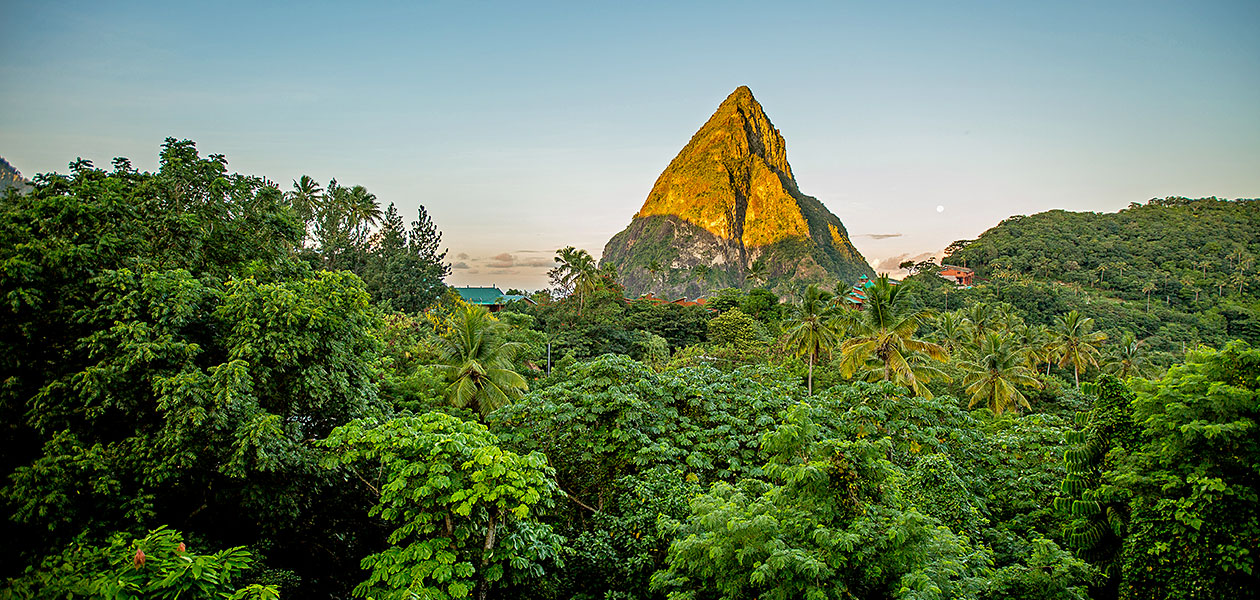Cocoa Estate
Our Cocoa Estate - The Rabot Estate - Saint Lucia
Welcome to our world...
The setting of the Rabot Estate cacao farm is jaw-droppingly beautiful. In front of you the twin Piton peaks emerge symmetrically from the Caribbean Sea. Behind you the rainforest stretches into the distance, studded with the gigantic peaks of Mount Gimie and plunging valleys. Right behind you is the Soufrière volcano and Sulphur Springs.
The 140-acre Rabot Estate is in the South West of St Lucia, near Soufrière – the original French capital. The estate is divided up into 16 different cortès or areas of terroir, with evocative names steeped in history, such as L’Hermitage, Ti Jardin, Marcial, Mathilde and Rameau.
The rich and fertile volcanic soil, high altitude (c.1000ft above sea level) and rainforest water all create a unique environment (terroir), perfectly suited to cocoa production, in which our cocoa trees flourish.
How we came to buy the Rabot Estate
Growing our own cocoa is a dream come true for everyone at Hotel Chocolat and it all started with a book from a member of our Chocolate Tasting Club. Here's the story...
Michele Clare was tidying out her husband's office, when, under a dusty pile of books, she saw a 1920 copy of Cocoa & Chocolate, Their History from cacao farm to Consumer. As a Tasting Club member, she immediately thought it would be of interest to Club Founder and Hotel Chocolat Chief Executive, Angus Thirlwell. She sent it off to him with the inscription, "I thought you might like to see this".
Angus Thirlwell recounts what happened next -
"I was just setting off on a trip to see my father, who lives in the West Indies, so slipped the book into my baggage. As a chocolate-obsessed person, I couldn't put it down once I'd started it. What I hadn't realised, and what I learned from the book, was how common it was for chocolatiers to make their own chocolate from the bean back in the 1920s and what an important cocoa-growing region the West Indies used to be.
Since then there have been huge changes - hardly any chocolatiers get involved in the bean any longer, buying all their chocolate ready made from specialist bean converters. And, unfortunately, cocoa growing has plummeted in the West Indies as bananas and tourism have taken its place. However, the beans from this part of the world are of high quality, primarily Trinitario.
I thought – why don't we grow our own cocoa and do the opposite of everyone else? And the prospect didn't just inspire and excite me - the whole company was behind it. After a long and thorough search, we found the beautiful but distressed estate in Saint Lucia. Co-founder Peter Harris and I raced over and, in the face of strong competition, signed contracts within a week to buy Rabot Estate, which had been in the same family since the 1930s. Contracts were finalised and Rabot Estate became ours in April 2006."
It's a bold move growing our own cocoa and it’s one that goes against the overall trend in the chocolate industry – to specialise more and more in a particular part of the chocolate making process. But Rabot Estate allows us to create a direct connection between our customers and the very the origin of chocolate, cocoa. We’re one of the very few in the world able to do this.
